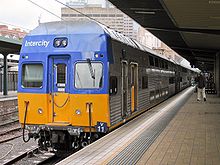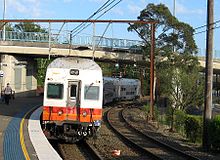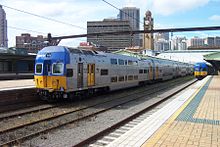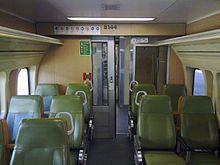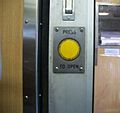- CityRail V set
-
Intercity V set 
V9 at Sydney Central in the 2005 'Intercity' livery.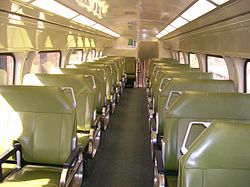
The upper deck of a V set refurbished in the late 2000s with resprayed panelling and new carpet.In service 1970–present Manufacturer Comeng Constructed 1970–1989 Formation 2, 3, 4, 6 (2 x 3-car or 1 x 2-, 1 x 4-car sets), 8 (2 x 4-car sets) Capacity 96 seated (driving cars), 112 seated (trailer cars). 192 in 2-car set, 304 in 3-car set, 416 in 4-car set. Operator RailCorp, as the product group CityRail Specifications Car length 23.968 m (78 ft 8 in) Width 2.928 m (9 ft 7 in) Height 4.382 m (14 ft 5 in) Weight 61 tonnes Gauge 1,435 mm (4 ft 8 1⁄2 in) The V set or DDIU (Double Deck Inter-Urban) is a class of electric multiple unit operated by CityRail in New South Wales, Australia. These stainless steel double deck trains operate on the Interurban lines of the CityRail network, serving the Blue Mountains, South Coast and the Central Coast to Newcastle.
Contents
History
First batch (DCF, DDC, DTF & DTC)
In 1968 the New South Wales Government Railways placed an order for the first batch 16 cars, with Commonwealth Engineering. Described at the time as the 'most luxurious commuter stock in the world',[1] they set new benchmarks for passenger comfort in Sydney. The cars made a first run from Sydney to Gosford on 10 June 1970, targeted as F111. This 4-car train was the first set to operate in revenue traffic from 22 June 1970, and all 16 cars were in operation by September of the same year.
These cars had many similar features to the later-built cars, including the one-piece moulded fibreglass front in royal blue & grey livery, semi-automatic doors, electronically controlled brakes and double-glazed windows. They did not have ditchlights (as they were considered unnecessary at the time), and had a different style of headlights.
There were:
- 8 Motor Cars - DCF 8001–8008 - Economy Class
- 4 Driving Trailer Cars - DDC 9001–9004 - 1st Class upper deck, Economy Class other seats
- 4 Trailer Cars - DTF 9011-9012 - Economy Class; DTC 9021–9022 - 1st Class upper deck, Economy Class other seats
The configuration of these cars was unsuccessful. The cars were fitted with AEI equipment, and the electrical equipment was split between the motor and trailer car. The cables were not able to provide the power needed to operate the train as proposed. This resulted in many failures of the train to operate and also failures in the air-conditioning system.
One class travel was introduced in September 1974, so the seating was all "economy class". This led to the refurbishment of the DDIU sets with the original luggage racks above the seating in the single deck section being removed. During this time the sets were targeted as U sets, the plates used on the then current single deck interurbans.
With the arrival of further V sets in the late 1970s and early 1980s, an excess of motor cars resulted and the decision was made to convert the 1970 cars to trailers and make them compatible with the later cars, thereby solving the reliability problems. The cars were rewired at Elcar Workshops, and the driver's compartment was removed and replaced by passenger toilets and luggage space.
The cars were subsequently renumbered:
- DCF 8001–8008 > DMT 9201–9207 (7 cars remained after writing off DCF 8004)
- DDC 9001–9004 > DDT 9208–9211
- DTF 9011–9012 & DTC 9021–9022 > DFT 9212–9215
Second batch (DCM & DCT)
During 1977 the second batch of DDIUs arrived, with many differences from the first batch. The electrical equipment was all mounted on the motor car, using Mitsubishi Electrical Equipment; they had stainless steel underframes; and they were fitted with vacuum retention toilets, used for the first time in NSW. These cars were the first of the "V sets", with the V showing that they were installed with vacuum retention toilets. They operated separately from the 1970 cars, as the two types were not compatible with each other.
The cars built were:
- Motor Cars - DCM 8021–8036
- Driving Trailer Cars - DCT 9031–9044
The driving trailers were not used that much, due to driver complaints about an uncomfortable "kick" when the motor car started to push the trailer. The controls in the DCTs were gradually stripped and replaced defective ones on the DCMs. However, during the "Citydecker" refurbishment by Goninan, DCT 9031–9036 were recabbed and recoded DTD. At the same time the DCMs were refurbished, receiving destination indicators and ditchlights. The refurbishment also saw the installation of air-conditioning in the driver's cabs of the DCMs: their lack of air-conditioning resulted in a union ban on using them as leading cars. DCM 8032–8036 were modified to have wheelchair seating, and recoded DTM. The DCMs that had destination indicators eventually had them removed and replaced with a metal blanking plate, after a decision not to use them on Interurban runs.
Third batch (DIM & DIT)
The first V sets were a success, and in 1982 DIM Motor Cars were introduced. There were no more driving trailers built, but new trailers, coded DIT, was built. These cars had increased seating compared with the DC series, up from 88 to 96 for the motor cars, and from 92 to 112 for the trailers.
The cars built were:
- Motor Cars - DIM 8037–8092
- Trailer Cars - DIT 9101–9184
DIM 8037-8068 were built with a wood paneling interior, and without ditchlights. These were the last cars to be delivered in the 'Blue Goose' livery. They were eventually fitted with ditchlights during refurbishment.
DIM 8069-8092 were built with a slightly different style of interior arrangement, and newer air conditioning technology. These can be distinguished from the earlier DIMs by the air-conditioning grille cover, and were delivered with ditchlights.
DJM and the rest of DIT cars
Advancements in technology saw a thyristor chopper system fitted to the next batch of motor cars, coded DJM. The chopper cars gave a smoother and quieter ride. The chopper cars can be distinguished from the earlier "camshaft" cars by a large open grille at the pantograph end of the motor car, and by different hatch coverings over the driver's side of the motor car. DJM 8123–8137 had even larger open grilles on the pantograph end. These cars were the first V sets to be painted in the State Rail "Candy" Livery, and were delivered with the rest of the DIT trailer cars. Motor car DJM 8101 had its "Candy" livery repainted into a CityRail blue and yellow scheme in 1990 to form a special set, with the commemorative wording "celebrating 20 years of double-deck intercity services to Gosford" applied near the driver's cab window. In 2009 DJM 8101 was repainted into standard 'Intercity' livery.
Final batch (DKM & DKT)
The final V sets were introduced in 1989, and they were the last cars to come out from Commonwealth Engineering Granville Plant. These cars were coded DKM and DKT and are permanently coupled. There were several changes: the cars were finished in corrugated steel, instead of the previous inserted Budd fluting. Seating had separate seat backs. Instead of the push-pull doors inside the previous V sets, the DKs were fitted with an electronically operated vestibule door, and no door was installed at the gangway. This was done so that passengers could access the toilets more easily and the DKM and DKT cars were permanently coupled in 2-car configuration with another 2-car chopper V set, forming a 4-car set.
14 cars were built:
- 7 Motor Cars - DKM 8139–8145
- 7 Trailer Cars - DKT 9185-9191
There was a proposal for 50 more to be built, but that order was never placed. Recently the DK Sets have had their vestuible doors fixed with a new button to open them
In service
V sets operate on the following lines:
- South Coast Line - Central to Kiama or Port Kembla (occasionally) - usually serviced by OSCARS
- Blue Mountains Line - Central to Lithgow
- Newcastle and Central Coast Line - Central to Newcastle
The V sets were a great success. In the 2000s a blue and yellow livery ("Intercity") was progressively applied to the fleet, largely unifying the appearance of the trains.
Accidents
- On 16 January 1976, a 6-car DDIU broke down at Glenbrook. Locomotive 4623 struck the rear car (DCF 8004), killing one passenger and injuring several others. DCF 8004 was the first car to be scrapped in its class.
- DCM 8030 was written off after an accident near Lapstone.
- DCM 8027 was rebuilt after an accident at Katoomba, with the DK series V sets.
- DJM 8107 was written off after an incident at Lawson.
- DIMs 8037, 8048 and 8060 were written off after accidents.
- On 6 May 1990, the Cowan rail accident occurred. A special passenger train hauled by steam locomotive 3801 stalled while attempting to climb the steep gradient from the Hawkesbury River to Cowan, New South Wales, Australia. It was struck from behind by a following V set service due to a signaling anomaly.
- On 2 December 1999, DIM 8067 collided with the rear car carrier of the Indian Pacific in the Glenbrook train disaster. 8067 was rebuilt along with DCT 9034 (which was used for parts), and both have been renumbered DIM 8020 (8067) and DET 9216 (9034 — the ex-"Contura" conference car).
- DIM 8020 was recently[when?] moved out of the Petersham training centre, where it had been since 2005 as a training car. It has been replaced by 2 Comeng Suburban R set cars.
- DIM 8065 was recently[when?] involved in a shunting accident at the shunting neck at Flemington Maintenance Centre. It has since been moved, and is awaiting repair.
- On 5 July 2011, V13's front car DCM 8028 was crushed by a falling tree during heavy winds in the Blue Mountains near Medlow Bath station.
Withdrawal
The first batch of cars was withdrawn in late 2005 due to corrosion in the underframes: these cars had low-carbon mild steel underframes instead of the stainless steel used on later batches). DMT 9204 was subsequently destroyed in an emergency services training exercise on 25 November 2008.
In January 2011 an additional 25 OSCAR cars were ordered to replace the 1977 batch of V sets, which are currently being withdrawn.[2]
Gallery
See also
- CityRail
- List of rail accidents
References
- ^ NSW Double-Deck Interurbans Turn 30, Railway Digest, June 2000
- ^ "25 more Oscar carriages on the way". CityRail. 2011-01-18. http://www.cityrail.info/news/2011/110118-oscars.
Further reading
Beckhaus, John; Halgren, Stephen (2007). Sydney's Electric Trains. Australian Railway Historical Society NSW Division. ISBN 978 0 9757870 8 3
External links
Sydney and New South Wales Rail Rollingstock NSWGR steam locomotive X10 class • Z11 class • Z12 class • Z13 class • Z14 class • Z15 class • Z16 class • Z17 class • Z18 class • Z19 class • Z20 class • Z21 class • Z23 class • Z24 class • Z25 class • Z26 class • Z27 class (2705) • Z28 class • Z29 class • C30 class (3112) • C30T class (3016T) • C32 class (3237) (3265) • C34 class • C35 class (3526) • C36 class (3642) • C38 class (3801) (3820) (3830) • D50 class • D53 class • D55 class • D57 class • D58 class • D59 class (5917) • AD60 classNSW Private Steam SMR10 classDiesel locomotive Electric locomotive Electric multiple unit U set • L, R, and S sets • K set • C set • V set • T & G sets (Tangara) • M set (Millennium) • H set (OSCARs) • A set (Waratah)Diesel railcar Categories:- CityRail
- Electric multiple units of Australia
Wikimedia Foundation. 2010.

